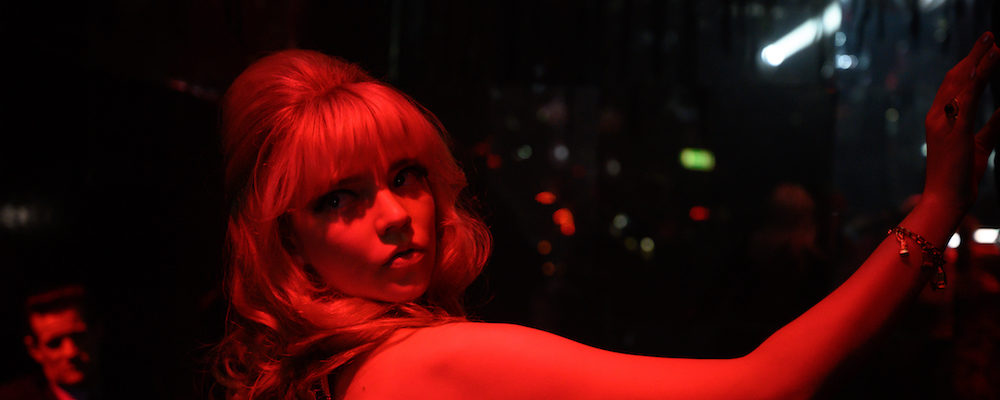Edgar Wright’s ‘Last Night in Soho’ Swirls Murderous Dread With Mind-Bending Color
Alci Rengifo
There is no more powerful tool for nostalgia than film. With the right cinematography, music, sets and costumes, a bygone era comes back to life, or some idea of it. “Last Night in Soho” embodies two distinct ideas about nostalgia: The desire to live in another moment in history and how romanticizing the past hides all of the darker truth. We like to idealize the 1960s for its fashion, music and political turbulence, but there were just as many broken hearts walking around and murderous personalities. For director Edgar Wright it is a continuation of his love for colorful filmmaking driven by needle drops and breakneck energy. The difference is that he applies his aesthetic techniques here to a mixture of noir and psychological thriller, never surpassing himself but never boring us.
The story begins in the present. Eloise (Thomasin McKenzie) is the kind of sheltered girl who wants to pursue big dreams in the big city, which for her means London. She’s had a nice home in rural England with grandmother Peggy (Rita Tushingham), who took care of her following an absentee father and a mother who died by suicide. With Beat headphones firmly on, listening to her favorite ‘60s hits, Eloise hops on the train and makes her way to fashion school. London life soon proves far from romantic. Her roommate turns out to be mean girl Jocasta (Synnove Karlsen), who with her loyal pack make fun of Eloise’s reserved ways and music taste. Frustrated, Eloise moves out to a flat owned by Ms. Collins (Diana Rigg in her last major role) near Soho Square. At night, when Eloise leaves her records playing and goes to bed, something startling happens and she’s transported back to the “Swinging London” of over 50 years ago. Here she encounters Sandie (Anya Taylor-Joy), an aspiring singer who falls under the sway of Jack (Matt Smith), an underworld operator and pimp. What seems like time travel turns out to have haunting consequences for Eloise’s life in the present.
Among modern directors, Edgar Wright has developed a cult following based on his vivacious style and genre-swapping. Originally famous for his quirky satires and comedies, like “Hot Fuzz” and “Shaun of the Dead,” he seems to be propelled now by following new inspirations. In 2017 he made “Baby Driver,” an exhilarating exercise in action cinema driven by its soundtrack that felt like a French New Wave outlaw movie meets old MTV. Now Wright switches tones again with “Last Night in Soho,” which taps into a noir-terror root going back to films like “Sisters” and “The Tenant.” The humor this time around is acidic and there’s a sense of dread all around, even in energetic music numbers. Wright is almost trying to channel his inner David Lynch with eerie scenes where Anya Taylor-Joy rehearses “Downtown” in a darkened theater or is trapped in a weird cabaret performance of Sandie Shaw’s “Puppet on a String” before leering men in suits. Eloise’s psychological state begins to break down and we aren’t sure if she’s just watching Sandie or becoming one with her in the past. Back in the waking world, Eloise starts having terrifying visions that of course begin to ruin her social life. What we can be sure of is the menacing presence(s) haunting sweet Ms. Collins’ dwellings. In more nods to Lynch and Brian De Palma, the lighting switches to hot reds and flashing blues.
“Last Night in Soho” develops like a recognizable thriller with typical features out of the “college kind of sucks” playbook. Aside from the mean girls Eloise starts seeing a fellow student who ends up having the bad luck of trying to sleep with someone traversing timelines and losing her mind. A murder mystery is layered on top of it all and Eloise begins investigating the past history of her building and Soho Square, with much suspicion landing on an ominous older man wandering near the pub where Eloise gets a job, played with perfect menace by Terence Stamp. Yet it works because Wright isn’t just making a nostalgia movie that could double as a playlist. It can become an unnerving commentary on the nature of nostalgia itself. Eloise is in love with the look and sounds of an era, but once she gets to travel there the popping colors are mascara for the tribulations of Sandie. Anya Taylor-Joy and Matt Smith pop into frame like fantasies out of some technicolor romance like “The Umbrellas of Cherbourg,” complete with dance numbers. Then Jack reveals his true nature as a criminal who entraps Sandie in a horrible nightmare. It’s the endless story of the attractive face seeking fame and finding horror instead.
Like many Wright films, this one is at times enjoyable on a purely sensuous level. The art direction by Marcus Rowland is exquisite and the cinematography by Chung-hoon Chung, who has lensed gothic thrillers like “It” and rich dramas like “The Handmaiden,” feels alive with its palettes. Wright tries to explore so many avenues in the screenplay co-written with Krysty Wilson-Cairns that the final, twisty finale can feel tagged on or recycled, although it’s pulled off with bloody suspense. All the same, “Last Night in Soho” is a thriller with craft. It’s not the same old nostalgia train in the same way this director is driven to not deliver the same old movie we might expect from him. He’s still trying new things and that drive comes across in a thriller with recognizable elements delivered with murderous gusto.
“Last Night in Soho” releases Oct. 29 in theaters nationwide.

